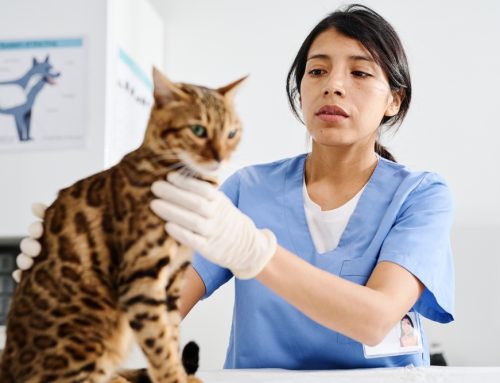Traditional Chinese medicine (TCM), which has been used for thousands of years in human medicine, is now helping to promote healing in pets and to extend their life. Our Creature Comforts Veterinary Service team is trained and knowledgeable in TCM, and we provide information about how Chinese veterinary herbal medicine is used, so you can determine if your pet can benefit from this age-old practice.
Chinese veterinary medicine theory
Chinese veterinary medicine (CVM) is based on the Daoist worldview that sees the body as a microcosm of the surrounding universe—meaning that the cosmic laws and forces that govern the external world also govern the body’s internal systems. The theory involves the following principles:
- Yin-yang theory — Dualism features prominently in CVM. This theory explains how opposing universal forces, such as light and dark, and hot and cold, collaborate and interact to affect physiological function and disease.
- The five elements theory — The ancient Chinese observed five annual seasons—spring, summer, late summer, autumn, and winter—which they corresponded to five elements—wood, fire, earth, metal, and water. They also correlated a pet’s life cycle as passing through these seasons (e.g., a puppy is in the wood or spring phase and a senior dog is in the water or winter phase). In addition, the bodily organs are mapped to the five phases:
- Wood – Liver
- Fire – Heart
- Earth – Spleen
- Metal – Lungs
- Water – Kidneys
- Five fundamental substances — CVM considers these substances vital to life:
- Qi and xue – Blood
- Jinge – Body fluids
- Jing – Essence
- Shen – Spirit
- Six common pathogens — CVM considers six elements—wind, cold, dampness, dryness, fire, and summer heat—as pathogens that cause illness.
Chinese veterinary medicine branches
CVM is comprised of four main treatment modalities:
- Acupuncture — Acupuncture involves stimulating body points, typically by inserting specialized needles along the body’s meridian channels.
- Herbal medicine — Herbal ingredients are administered in particular combinations or formulas to treat certain diseases.
- Food therapy — Food therapy involves tailoring diets based on the food’s energetics to treat and prevent body imbalances.
- Tui-na — Tui-na is a Chinese medical massage that promotes Qi circulation and corrects organ systems imbalances.
Chinese veterinary medicine pattern diagnosis
Similar to a Western veterinary medicine exam, every CVM examination starts with a thorough history and physical examination, but the evaluation proceeds with identification of the underlying “pattern” of disharmony. This approach considers the disease signs, and how the signs relate to the individual patient. The pet’s temperament, age, sex, activity level, and environment are considered when making a diagnosis. Other evaluations include:
- Tongue — The patient’s tongue provides a great deal of information, because each tongue region represents an organ system, and the color provides information about that body system’s health. Representations include:
- Pallor — Deficiency
- Redness — Excess
- Deep purple — Stagnation
- Skin and hair coat — Assessing a pet’s skin can help detect deficiencies and excesses throughout the body, and palpating the back-shu points can provide information about the musculoskeletal system.
- Femoral pulses — The femoral pulses are divided into regions linked to the heart, lungs, liver, gallbladder, bladder, kidneys, and intestines. Palpating the pulse quality at each region can help determine a pattern diagnosis.
Conditions treated by veterinary herbal medicine

Chinese veterinary herbal medicine is commonly used as a complementary therapy with Western veterinary medicine for a variety of health conditions, including:
- Immunologic disorders — The complex immune system involves endocrine and neurological activities that must work to obtain body balance. Any attempt to modify the immune system must consider this relationship, as well as environmental influences. Herbs can address more than one unbalanced body process.
- Cancer — In TCM, cancer is typically viewed as a sign of systemic toxicity. Herbs can help manage chemotherapy effects, assist in recuperation after radiation or surgery, complement conventional cancer treatment, assist in cancer prevention, and support various systems affected by cancer.
- Cardiovascular disease — Herbs can help cardiac patients by assisting with optimizing cardiac output, potentially preventing arrhythmias, and decreasing oxidative stress.
- Dermatologic disease — In TCM, skin disorders are considered manifestations of deeper disease processes that indicate metabolic body imbalance. Therefore, topical and systemic herbal treatments are typically recommended for dermatological disease.
- Gastrointestinal (GI) tract disorders — The GI tract is central to systemic health. Visceral reflex relationships between the gut and other mucous membranes in the body are employed in herbal medicine, so anything that improves digestion will improve other body tissues.
- Arthritis — Toxin accumulation may be related to joint pain and inflammation. Herbs can help normalize gut function, as well as address joint and muscle pain and inflammation.
- Respiratory disorders — Herbs are used in many ways to treat respiratory disorders. Expectorants can be used to remove excess mucus, demulcents to reduce irritation, antitussives to prevent coughing, suppressants to inhibit the coughing reflex, and antimicrobials to reduce infection.
- Urinary tract conditions — Herbal medicine uses diuretics to enhance waste excretion through the kidneys.
Chinese veterinary herbal medicine is a useful practice that has many applications to promote health and wellbeing in pets. If you think your pet can benefit from Chinese veterinary herbal medicine, contact our Creature Comforts Veterinary Service team. We will perform a pattern diagnosis and determine an appropriate treatment regimen.







Leave A Comment